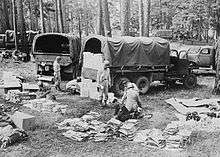Louisiana Maneuvers
The Louisiana Maneuvers were a series of U.S. Army exercises held around Northern and Western-Central Louisiana, including Fort Polk, Camp Claiborne and Camp Livingston, in 1940 and 1941. The exercises, which involved some 400,000 troops, were designed to evaluate U.S. training, logistics, doctrine, and commanders.
Many Army officers present at the maneuvers later rose to very senior roles in World War II, including Omar Bradley, Mark Clark, Dwight D. Eisenhower, Walter Krueger, Lesley J. McNair, Joseph Stilwell, and George Patton.
Background
When Nazi Germany invaded Poland in 1939, starting World War II, the U.S. Army was largely an infantry force with supporting artillery, engineers, and cavalry, as well as combat support and combat service supporting arms. It was far smaller than most European armies, and few units were motorized or mechanized. As war approached, there was a need to both modernize the force and to conduct large-scale maneuvers to test all aspects of a fast-growing, inexperienced force. General Leslie McNair and Colonel Mark Wayne Clark picked thousands of acres of unused land in Louisiana as a good place for large-scale training.[1] The war games were conducted while the British awaited an expected German invasion of the United Kingdom,[2] and some speculated that the National Guard units used in the maneuvers would not be demobilized afterwards.[3]
Exercises

Around 400,000 troops were divided into equal armies of two fictitious countries: Kotmk (Kansas, Oklahoma, Texas, Missouri, Kentucky), also called the Red Army; and Almat (Arkansas, Louisiana, Mississippi, Alabama, Tennessee), or the Blue Army. The troops were organized into a total of 19 divisions.
From August to September 1941, the armies fought over 3,400 square miles (8,800 km²) of Louisiana. The area spanned from the Sabine River east to the Calcasieu River and north to the Red River.
They fought over navigation rights and strategic points along the Mississippi River.[4]
Omar Bradley, who participated in the exercises, later said that Louisianans welcomed the soldiers with open arms. Some soldiers even slept in some of the residents' houses. Bradley said it was so crowded in those houses sometimes when the soldiers were sleeping, there would hardly be any walking room. Bradley also said a few of the troops were disrespectful towards the residents' land and crops, and would tear down crops for extra food. However, for the most part, residents and soldiers established good relations.[5]
During the exercises, 26 men died, most from drowning in the Sabine River or in vehicle accidents. One died when struck by lightning, and one had a heart attack at age 24.[6]
This exercise also led to the creation of Fort Polk, named for the Confederate General Leonidas Polk.
Lessons
The U.S. Army fighting doctrine was based around the ideas of mass and mobility. The constabulary-type Army of the antebellum frontier days was based on a high level of mobility, while the Union Army that won the U.S. Civil War massed combat power in a series of campaigns aimed at the heart of Confederate strength. These two legacies shaped U.S. doctrine leading up to World War II.
Built around a nucleus from Chaffee's 7th Mechanized Cavalry, the 1st U.S. Armored Division tested the ability of a very large combined-arms mechanized unit to move long distances, maintain troops and vehicles in combat conditions, and affect the outcome of tactical and operational-level problems. The armored division concept was considered sound and led to the formation of 16 U.S. armored divisions during World War II.
U.S. defensive doctrine was based on the perceived need to defeat German blitzkrieg tactics; U.S. units expected to be faced with large numbers of German tanks attacking on relatively narrow fronts. The maneuvers tested the concept of the tank destroyer. This concept, originating with artillery officers, consisted of large numbers of highly mobile guns to be held in reserve. Upon an enemy tank attack, the towed or self-propelled tank destroyers would be rapidly deployed to the flanks of the penetration with the intent of taking a heavy toll of attacking tanks. Tank destroyers were supposed to employ aggressive, high-speed hit-and-run tactics against tanks. The use of these guns was distinct from the forward placement of towed antitank guns assigned as a normal part of the Infantry Regiment. The Louisiana Maneuvers' data showed that the Infantry's AT guns took a much higher toll on "enemy" tanks than did the tank destroyer battalions' guns. However, the conclusion drawn was that a tank destroyer force of independent tank destroyer battalions should be raised.
In actual practice during World War II, such massed enemy tank attacks rarely happened; indeed, throughout the war only one TD battalion ever fought in an engagement quite like that which had originally been envisaged, at the Battle of El Guettar. The Tank destroyer command eventually numbered over 100,000 men and 80 battalions equipped with 36 tank destroyers or towed anti-tank guns each. Immediately after the war, the force was disbanded and the anti-tank role was formally taken over by the Infantry, Engineer and Armor branches.
The exercise was also notable for the first wide-scale testing of the new C ration. Valuable data was obtained regarding weight of meals, composition and shape of can used. The resulting amendments produced the standard "C" field ration used by U.S ground forces for the bulk of World War II.
References
- ↑ Gilbert, Martin:"The Second World War: A Complete History", 2004
- ↑ "Next Week May See Nazis Attempt British Invasion". St. Petersburg Times. 1940-08-03. p. 1. Retrieved 4 May 2014.
- ↑ "Local National Guard Unit Off for Giant War Games". St. Petersburg Times. 1940-08-03. p. 2. Retrieved 4 May 2014.
- ↑ "The Louisiana Maneuvers". State of Louisiana National Guard. Retrieved 2008-02-07.
- ↑ Bradley, Omar N.:Omar N. Bradley: A Soldier's Story, 1951
- ↑ "Battlefield of Louisiana". Velmer Lenora Smith, DeRidder Historian. Retrieved 2008-02-07.
External links
- World War II – Louisiana Maneuvers
- More Stories of the Great Louisiana Maneuvers Alt archive link
- 1941 Louisiana Maneuvers: The Big One